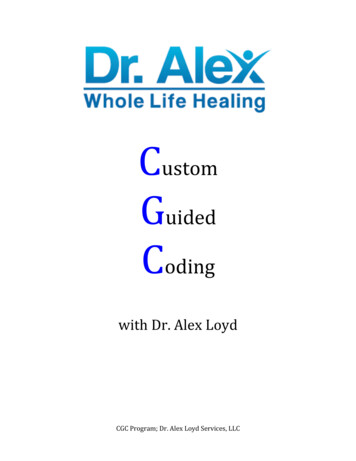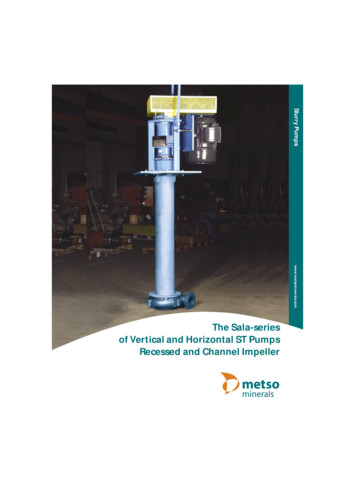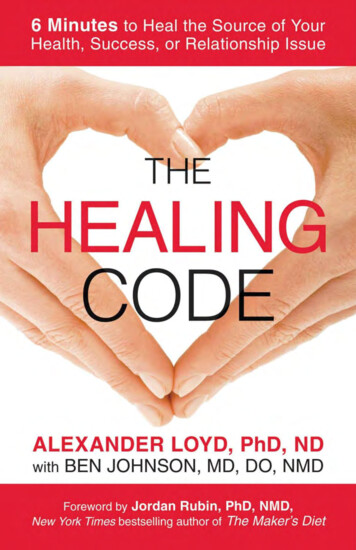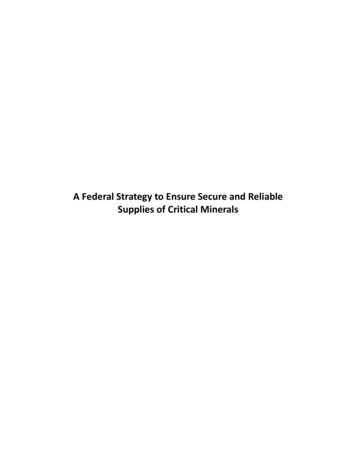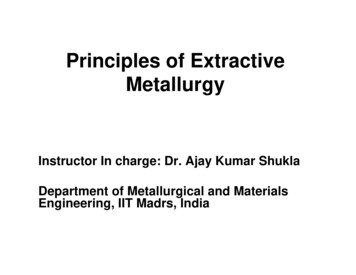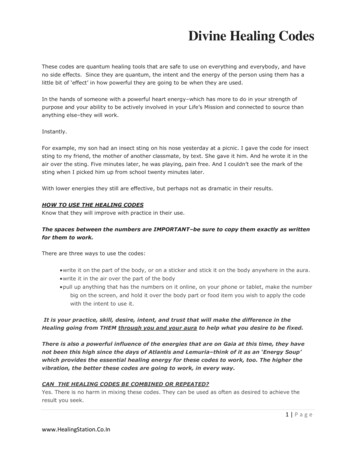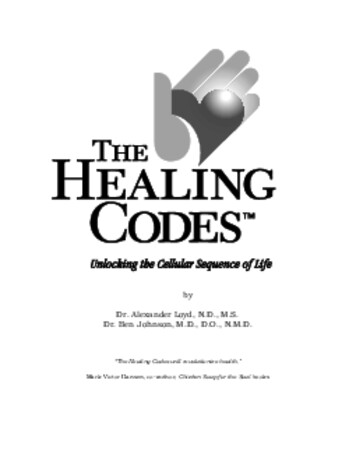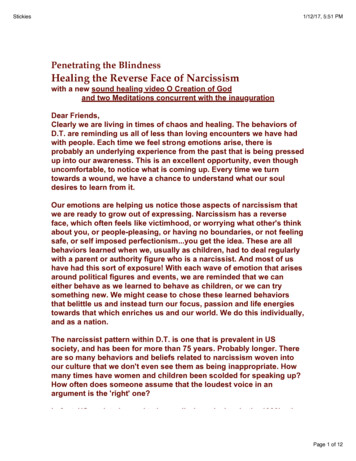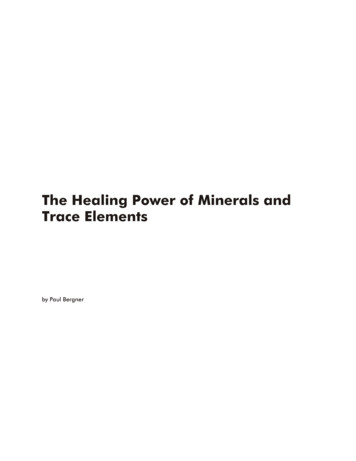
Transcription
The Healing Power of Minerals andTrace Elementsby Paul Bergner
Published by North American Institute of Medical Herbalism, Inc.P.O. 20512, Boulder, CO, 80308 303-541-9552Copyright Paul Bergner 2003 All rights ReservedAcknowledgementsThe completion of this book would have been impossible without thecontributions of Jonathan Merritt and Jenifer Means, N.D., L.Ac, whoresearched and wrote the first draft of Section II.Thanks also to Sally Fallon, who steered me right on some of the finepoints of Weston Price’s research, to the Price-Pottenger Foundation forpermission to reprint photographs from Nutrition and Physical Degeneration, byWeston Price, and to Ryan Drum, Ph.D, for world-class information on seavegetables.I also used The Kellogg Report: the Impact of Nutrition, Environment,and Lifestyle on the Health of Americans, by Dr. Joseph Beasley, as a primaryresource for background information.DedicationTo Weston and Florence Price, for their courage on their world travelsand sceintific endeavors, and to Monica Price and the volunteer directors ofthe Price-Pottenger Nutrition Foundation for preserving their work.DisclaimerNAIMH, Inc has designed this book to provide information in regard to thesubject matter covered. It is sold with the understanding that the publisherand the author are not liable for the misconception or misuse of informationprovided. Every effort has been made to make this book as complete andaccurate as possible. The author and NAIMH, Inc shall have neither liabilitynor responsibility to any person or entity with respect to any loss, damage, orinjury caused or alleged to be caused directly or indirectly by the informationcontained in this book. The information presented herein is in no way intendedas a substitute for medical counseling.
Table of contentsIntroduction: The Alchemy of minerals · · · · · · · · · · 1Chapter One: From the earth to your body · · · · · · · · 3From the cosmos to your table· · · · · · · · · · · · · 6From sun to earth · · · · · · · · · · · · · · · · · · · 6From earth to sea: where life arose · · · · · · · · · · 8Minerals in the food chain of the sea · · · · · · · · · 12The inner sea of land animals · · · · · · · · · · · · · 13Conclusion: the last stage of the chain · · · · · · · · 17Chapter Two: Traditional vs modern foods · · · · · · · · 19Weston and Florence Price · · · · · · · · · · · · · · · 20The traditional diets · · · · · · · · · · · · · · · · · · 22The modern foods. · · · · · · · · · · · · · · · · · · · 24Wild game vs domestic meat · · · · · · · · · · · · · · 28What was lost· · · · · · · · · · · · · · · · · · · · · · 29Risk factors in the Western diet · · · · · · · · · · · · 31Chapter Three: The Food Chain Broken · · · · · · · · · · 33Soil mineral depletion · · · · · · · · · · · · · · · · · 34The story of NPK · · · · · · · · · · · · · · · · · · · · 37Pesticides and fungicides · · · · · · · · · · · · · · · 40Early harvesting and nutrient content· · · · · · · · · 41The smoking gun · · · · · · · · · · · · · · · · · · · · 41Green leafy vegetables · · · · · · · · · · · · · · · · · 44
Beans · · · · · · · · · · · · · · · · · · · · · · · · · · 45Grains · · · · · · · · · · · · · · · · · · · · · · · · · 46Meats · · · · · · · · · · · · · · · · · · · · · · · · · · 46The averages · · · · · · · · · · · · · · · · · · · · · · 47USDA Food Composition Data · · · · · · · · · · · · · 48Trace elements · · · · · · · · · · · · · · · · · · · · · 49Comparative data from 1914· · · · · · · · · · · · · · 50Organic vegetables · · · · · · · · · · · · · · · · · · · 52What can be done for the soil? · · · · · · · · · · · · · 53USDA research · · · · · · · · · · · · · · · · · · · · · 55John Hamaker · · · · · · · · · · · · · · · · · · · · · 56Chapter Four: Trouble at the top of the food chain · · · · 57The Surgeon General’s blind spot · · · · · · · · · · · 57The mineral status of Americans · · · · · · · · · · · 58Scientific flaws in the USDA diet surveys · · · · · · · 59Medical education of physicians · · · · · · · · · · · · 60Registered Dieticians · · · · · · · · · · · · · · · · · · 62Mineral malnutrition and disease · · · · · · · · · · · 63Chapter 5: Minerals and disease· · · · · · · · · · · · · · 67The conventional model of a deficiency disease · · · · 67The pathology of multiple mineral deficiencies · · · · 68Chapter 6: Getting the minerals you need· · · · · · · · · 76Traditional diets · · · · · · · · · · · · · · · · · · · · 76
Japanese diets · · · · · · · · · · · · · · · · · · · · · 77The French Paradox · · · · · · · · · · · · · · · · · · 77The diet in 1900 · · · · · · · · · · · · · · · · · · · · 78Sugar · · · · · · · · · · · · · · · · · · · · · · · · · · 81Red Meat · · · · · · · · · · · · · · · · · · · · · · · · 84Organ meats · · · · · · · · · · · · · · · · · · · · · · 86Fish · · · · · · · · · · · · · · · · · · · · · · · · · · · 87Oils · · · · · · · · · · · · · · · · · · · · · · · · · · · 90Olive oil · · · · · · · · · · · · · · · · · · · · · · · · · 93Eggs· · · · · · · · · · · · · · · · · · · · · · · · · · · 94Milk and milk products · · · · · · · · · · · · · · · · 95Soy products · · · · · · · · · · · · · · · · · · · · · · 98Grains · · · · · · · · · · · · · · · · · · · · · · · · · 99Fruits and Vegetables · · · · · · · · · · · · · · · · · 101Soups · · · · · · · · · · · · · · · · · · · · · · · · · · 103Pickles and sauerkraut· · · · · · · · · · · · · · · · · 104The vegetable fast · · · · · · · · · · · · · · · · · · · 104Juicing · · · · · · · · · · · · · · · · · · · · · · · · · 104Salt · · · · · · · · · · · · · · · · · · · · · · · · · · · 105Sea vegetables · · · · · · · · · · · · · · · · · · · · · 106Herbs and spices · · · · · · · · · · · · · · · · · · · · 108Chapter 7: Therapeutic diets· · · · · · · · · · · · · · · · 113Low fat diets · · · · · · · · · · · · · · · · · · · · · · 113
Vegetarianism · · · · · · · · · · · · · · · · · · · · · 117Vegans · · · · · · · · · · · · · · · · · · · · · · · · · 120The macrobiotic diet. · · · · · · · · · · · · · · · · · · 121Chapter 8: Absorption · · · · · · · · · · · · · · · · · · · 123Interactions between minerals · · · · · · · · · · · · · 124Digestion · · · · · · · · · · · · · · · · · · · · · · · · 125Absorption · · · · · · · · · · · · · · · · · · · · · · · 127Chapter 9: Mineral Supplements · · · · · · · · · · · · · 129Potential harmful effects · · · · · · · · · · · · · · · · 130Forms · · · · · · · · · · · · · · · · · · · · · · · · · · 131Ionized minerals · · · · · · · · · · · · · · · · · · · · 132Colloidal minerals · · · · · · · · · · · · · · · · · · · 132Closing Note · · · · · · · · · · · · · · · · · · · · · · · · 136Appendix A Practitioners · · · · · · · · · · · · · · · · · · 137Appendix B Products · · · · · · · · · · · · · · · · · · · 138Appendix C Books · · · · · · · · · · · · · · · · · · · · · 140Appendix D Information sources · · · · · · · · · · · · · 141Appendix E: Photographs · · · · · · · · · · · · · · · · · 142References · · · · · · · · · · · · · · · · · · · · · · · · · 153
Healing Power of Minerals and Trace ElementsIntroductionThe Alchemy of mineralsThe European alchemists of the Middle Ages worked andexperimented extensively with minerals. They strove to complete the “GreatWork” — to turn lead into gold. The alchemist’s labors consisted of acquiringtheir minerals — many more than just lead and gold — purifying themchemically, and combining them in various ways, seeking to discover thescience of their transformation. Alchemy is portrayed as ignorance today inbasic chemistry texts, but it ultimately gave birth to the modern sciences ofchemistry and nuclear physics.Alchemy in nature and nutritionA close look at the universe, at geology, biology, and human nutritionshows that alchemical transformation of minerals not only occurs, it is thehidden secret behind the way Nature works. In the radioactive turmoil of thesun, hydrogen is transmuted into all the natural elements in the universe —seventy-five of them minerals. The process continues in the hot magma deep inthe earth, and the minerals rise to be diffused throughout the earths crust anddissolved in the sea in the form of salts. Sea plants selectively assimilateminerals and concentrate them in the balance and proportions necessary forthe food of animals. In the earths crust and soil, bacteria and othermicroorganisms ingest and transform the minerals into a form suitable for thefood of land plants. The plants assimilate them to make suitable foods for theanimals. Animals, including humans, eat the plants or other animals. We’ll seein chapters 2 and 6 that a diet rich in both plant and animal foods providesoptimum nutrition for the human being. In the human body, the minerals actas catalysts, participating in enzyme systems that allow the transformation offood and the air we breathe into energy, vibrant health, and consciousness.Alchemy gone awry.Traditional farmer-alchemists throughout the history of agriculturehave been careful to return their mineral-rich plant and animals wastes to thesoil to preserve the minerals available to the soil bacteria and plants.Traditional peoples, we’ll see in Chapter 2, often went to great lengths to obtainmineral-rich foods, and consumed only natural foods. In Chapters 2 and 3, I’llshows how modern food processing and agricultural methods strip the soiland our foods of their mineral content, reducing their availability to thealchemist workshop of our bodies. In Chapters 2, 4, and 5, I’ll show the resultof the modern diet on the mineral-status of Americans.1
Healing Power of Minerals and Trace ElementsModern medicine, although its documents mineral deficiencies in thepopulation, generally ignores their significance, and employs powerful butinappropriate drugs instead of first respecting the natural alchemy of mineralsand health and restoring the optimal mineral nutrition of the body. The secretwork of the alchemists of the Middle ages was to turn the lead of the humancharacter into the gold of spirituality. We’ll see in Chapter 5 that if the mineralsin our body become deficient, we experience fatigue, irritability, depression,and anxiety, and our immune system begins to lose its edge over biologicalinvaders. We end up less able to perform our spiritual work, whether that beservice to our families, communities, to nature, to humanity, or to the Creator.Alchemy and the dietThe alchemist sometimes had to go to great lengths to acquire hismetals and the knowledge of how to use them. Today, we have to extend effort,and sometimes money, to seek out and acquire the mineral-rich foods werequire in our diet. We may also have to spend time cooking them, rather thaneating fast-food. In Chapters 6 through 9, I’ll tell how you, as a wise alchemist,can obtain your minerals from our food today, in spite of the generaldemineralization of the standard American diet and agricultural products, andassimilate them into your body. If we respect the pattern of the alchemy ofminerals in nature, and consume mineral-rich foods in their natural forms, ourhealth will improve, and we can go about our Great Work with more vigor,energy, mental clarity, and peace.2
Healing Power of Minerals and Trace ElementsChapter OneFrom the earth to your bodyAll flesh is grassIsaiah 40:6Ninety two naturally-occurring elements appear in nature, all derivedfrom nuclear reactions, either in the sun or deep within the earth. Seven ofthese are radioactive, and six are inert gasses. These thirteen elements have noimportant role in living things. Four elements — carbon, hydrogen, oxygen, andnitrogen — are the basic building blocks of organic life. The remainingseventy-five elements are classified as minerals, and their role in health anddisease is the subject of this book.Scientists have either proven or suggested a beneficial role for thirty ofthese in animal life (See Table 1.1). The remaining forty-five minerals may ormay not have a role in health and disease. For the most part, they have notbeen investigated. These other minerals exist in living things in such a smallconcentration — parts per million or parts per billion — that analyticalequipment has only been available to measure their presence for a few decades.Some of the minerals in Table 1.1 have important biological functions at suchtiny concentrations. In the future, the importance of many more of theseminerals to life may eventually be identified. Most of them exist in the naturalenvironment of the sea, where life arose, and are present in the rocks and soilsof the earth, so it seems reasonable to propose that some of them may havesome important role in animal life.Table chlorinechromiumcobaltcopperThirty minerals beneficial to animal umsiliconsodiumsulfurtinvanadiumzinc*Several of these are beneficialin tiny doses, but poisonous atlarger doses.
Healing Power of Minerals and Trace ElementsMinerals as a class of nutrients have three major roles in the body: 1)Theyprovide structural materials for the bones and other connective tissues, 2)Theyallow electrical impulses to move along the nerves, and 3)They act as catalystsor support the role of enzymes in physiological processes, such as reproductionof the DNA or manufacture of proteins. Catalysts and enzymes promote thetransformation of one thing into another. The spark plugs in your car are likecatalysts when they allow the transformation of gasoline into energy. Yourdigestive enzymes promote the transformation of the food you eat intocomponents that can be absorbed in the intestine. This role of the mineralsexplains the devastating effects that a deficiency of minerals in the body mayhave on the health. Magnesium participates in more than one hundredenzymatic reactions in the body, and zinc in more than two hundred. Adeficiency of these two minerals alone can thus result in three hundreddifferent things going wrong in your body. You would be like a car runningwithout all its spark plugs.Minerals in nutrition are conventionally divided between the majorminerals and the trace elements. The major minerals are those arbitrarilydefined by having a daily requirement of more than 100 milligrams. Note thatthis dose is at the level of parts per million for a 150 pound adult. The majorminerals iumsulfurThe remaining minerals in Table 1.1 are classified as trace elements.Some of these trace elements are active in the body in daily doses in the rangeof micrograms — one one-hundredth of a milligram — which falls in the rangeof parts per billion by weight for an adult human. Perhaps the most well-knownof the trace elements is iron, which was first discovered in the seventeenthcentury to be essential to health, and is added to many of our processed foodstoday to ensure that we do not develop deficiencies. Iodine is another example.It was discovered to be essential in the nineteenth century, when it was foundthat iodine supplements can cure or prevent goiter. Iodine is added to table saltto ensure that our public receives a minimum dose.Some minerals which are essential at tiny doses are extremelypoisonous in larger doses. They have been the subject of crime stories, politicalintrigue, and occupational tragedies, for centuries in Western civilization. Leadpoisoning from the water supply has even been proposed as the cause of the4
Healing Power of Minerals and Trace Elementsfall of the Roman empire. The most important toxic minerals appear below.Mercury is the only one on the list that is not beneficial in tiny doses.aluminumarseniccadmiumleadmercuryMost minerals, even calcium, can be toxic if you take too much ofthem, something that must be remembered when taking them as supplements.I’ll discuss supplements in great detail in Section 3.In section 1. I’ll describe how minerals get from the volcanic rock ofthe earth or the dissolved minerals of the sea to your body. I’ll explain howprimitive people following a traditional diet usually do not suffer from mineraldeficiency diseases, and how natural physician in the past have used wholemineral-rich foods and food-derived multi-mineral supplements to curedisease. I’ll show how the food chain can be broken by unwise agriculturaltechniques and how in fact our food has become radically demineralized in thelast century, and show the impact this has had on public health.5
Healing Power of Minerals and Trace ElementsFrom the cosmos to your tableWe created man from mud, molded into shapeQuran 15:26Whether we accept the revelations of the scriptures, or the theories ofevolutionary scientists, we reach the same conclusion: the human body ismolded from the elements of water and earth, from the materials in the earth’scrust, and from the elements in the water of the sea, mixed together like “mud”or “clay.” Most of the ninety naturally-occurring elements of the earth also existin the human body, and most or dissolved mineral elements of the sea occurnaturally in the human body fluids, and the combination of these elements isessential to life. The healthy human body is a microcosm of the earth: thephysical body composed of the elements of the earth and atmosphere andcarrying within it an inner sea. Continuing intake of many of these elements isnecessary to maintain health and prevent disease. In this chapter I’ll show howthe mineral elements of the earth and sea were formed and how they risethrough the food chain to reach the food on your table.From sun to earthThe earth was born from the sun. Scientists do not agree exactly howthis happened, but the sun spun parts of itself off, either as eruptions fromwithin itself, or as clouds of hot radioactive gasses. These materials cooled toform the planets. In the process of cooling, the radioactive elements of the sunformed many new elements — 92 in all have been identified, including theoriginal constituents of the sun. through the food chain.Hydrogen building blocksThe heat and radiation of the sun is generated by a massive ongoingnuclear hydrogen explosion. The hydrogen atom of the sun and other stars isthe basic building block of all the elements in the universe — minerals, gasses,radioactive, and other elements. Its atom contains a one proton and oneelectron. If we could freeze it in time would look figuratively like a tiny moonrevolving around a much larger planet. All the other elements aremanufactured from hydrogen protons and electrons, in the intense nuclearheat of stars, and in the scattering and cooling of star elements when a starexplodes in a supernova, as it spins off gasses or parts of itself which cool intoplanets, or in ongoing nuclear reactions deep within the planets. Six hydrogenatoms combined make up a carbon atom. Eleven make up the sodium in yourtable salt. Twelve make up magnesium; nineteen potassium, twenty calcium,and ninety-two make up uranium. Besides the ninety-two known to occurnaturally on earth, another thirteen have been created in nuclear reactors.6
Healing Power of Minerals and Trace ElementsSome of these have very short lives — only tiny fractions of a second — beforethey degrade into other elements.The cooling of the earth into layersThe earth cooled from its original matter into a revolving globe of hotliquid radioactive material. As heavier or lighter elements were formed throughongoing nuclear fusion or fission — the combining or splitting of existingelements — the heavy ones sank toward the core of the earth, and the lighterones rose. In the process of further cooling, hydrogen and oxygen formed thewater of the seas, and nitrogen, oxygen, and other gasses rose to form theatmosphere. Today, we can look at the earth and its environment in sevenlayers: a solid core, a molten outer core; a semi-solid mantle surrounding that,a thin dough-like layer called the Moho, the dry crust, the seas, and theatmosphere — all created from the original radioactive matter of the sun. Table1.2 shows the size and state of the different layers of the earth.Table 1.2The layers of the earthLayerStateSizeInner coreOuter liddough-likesolidliquidgas800 miles1350 miles1685 miles100 miles25 miles2.5 milesup to 13,000 milesThe layers of the earthThe earth continues to evolve geologically, and the center of activityfor this is in the mantle, composed of semi-solid radioactive rock. Within themantle are nuclear hot-spots called heaters by geologists. These heaters act asnuclear reactors, continually generating elements through the fusion of lighteratoms, in the same process that generated the layers of the earth. Due to theintense gravitational pressures of the earth above it, the radioactive elementssometimes reach critical mass, and a nuclear fission explosion — identical inprocess to that of a nuclear bomb — erupts. The explosion blows some materialdownward and some upward, and it is this upward force of the explosion whichcauses the rising and shifting of the land masses on the crust. When the forcesof these explosions break through the earths crust, we have a volcano. Theupward thrusts also scatter all the elements above them upward toward thecrust.7
Healing Power of Minerals and Trace ElementsGeologists believe that at one point in the evolution of the planet,volcanic activity predominated, with constant volcanic explosions spreadingdebris across the earth and into the atmosphere. This debris contains all theelements in the mantle and the layers above it, and in that era settled asmineral-laden dust covering the earth. The dust from a single large volcanicexplosion today can affect weather patterns throughout the globe. Imagine thedensity of the dust-mineral cloud at a time when the surface was dominated byvolcanoes. The mixing of the upthrust rocks and the settling volcanic debrishas covered the continents and the ocean floor with a well-balanced mixture ofall the minerals and other elements essential to life.The Moho layer — short for the Mohorovich discontinuity is significantbecause of its consistency. Think of it as something like bread dough, with thehot gooey radioactive thinner “batter” of the mantle beneath it, and the driedcrust of the earth above. The continents are constantly moving, although muchtoo slow for us to perceive, occurs across this doughy layer of matter beneaththem.The sea contains within it, in solution, most of the minerals of theelements of the crust beneath it, the volcanic dust which has settled in it, andmaterials washed into it by the rivers of the earth. Life arose in the sea,probably at its floor near the volcanic vents of the heaters below it.From earth to sea: where life arosePicture the earth before the continents arose. The globe is coveredwith a vast ocean, whose waters were much like today’s sea water — salty. Theocean then and the ocean today contain much more than the sodium andchloride of common table salt — the water holds sixty-five minerals, all floatingin solution (See Tables 1.3 and 1.4). Deep within the sea, at the hot volcanicvents on the ocean floor, the first living molecules were formed — proteinscapable of reproducing copies of themselves. These proteins were theprecursors of the deoxyribonucleic acid (DNA) and ribonucleic acid (RNA) in thenucleus of living cells that permit those cells to reproduce and carry on theirmetabolic functions. Scientist believe that the formation of these proteinsrequired both the heat of the volcanic ocean floor and the minerals in thewater. The DNA and RNA in the cells even today require these same mineralsfor reproduction.8
Healing Power of Minerals and Trace ElementsBox 1.1How small is a part per millionThe standard measure of mineral content in rock, water, plants,animals, and human beings is in parts per million, the measure I use in thetables in this chapter. A million is too large for most of us to conceive, sohere is a little arithmetic. Assume a pinch of salt — sodium chloride — isabout the size of a drop of water. Sixteen drops make one milliliter, thirtymilliliters makes about one ounce, thirty-two ounces make a quart, andfour quarts make a gallon. So a gallon contains a little more than 61,000drops of water, and a single drop would be one part per million in aboutsixteen gallons of water. Our pinch of salt is only about a half-pinch each ofsodium and chloride, however, so to get one part per million of each, we’dhave to put that pinch into about 32 gallons of water. This may seeminsignificantly small, but some minerals at such concentrations in plants,animals, and human are absolutely essential to life. Chromium, cobalt,manganese, molybdenum, and nickel — all essential to human life — arefound in the body in concentrations of less than one part per million. Someof the minerals in Table 1.3 — those with more than three zeroes after thedecimal point — are measures in parts per billion. It would take 32,000gallons of water to hold a concentration of one part per billion of our pinchof salt.The mineral-hunger of living cellsEventually living cells evolved, wrapping these original molecules oflife in a membrane. The membrane forms a barrier that allows the cell toselectively take in certain nutrients and minerals and concentrate them,creating an inner environment more favorable to the nuclear proteins in theirhunger to reproduce. The intracellular environment of a single-celled sea plantor animal contains most of the elements of the sea itself, but in very differentconcentrations. Table 1.5 shows how the cells of sea plants concentrate themineral of the sea, in some cases more than a million times. This tabledramatically demonstrates the mineral hunger of living cells. Some of theseminerals apparently increase the efficiency of the reproduction of DNA and RNAin the nuclei of plant cells9
Healing Power of Minerals and Trace ElementsTable 1.3Mineral elements in sea dhafniumiodineironlanthanumleadParts per le 1.4Other minerals in the seaSea water has not been tested in published research for a number of trace elements. The followingminerals do not appear in Table 1.2, but because they have been identified in sea plants ium10
Healing Power of Minerals and Trace ElementsTable 1.5How sea plants concentrate sea thoriumtintitaniumvanadiumzinczirconiumSea 0.000050.0030.0010.0020.010.0000022Sea plants(avg. 33333,0001,00015,000909,090
Healing Power of Minerals and Trace ElementsMinerals in the food chain of the seaThe phrase “Big fish eat little fish, little fish eat worms, and worms eatmud,” is not accurate. In reality big fish eat little fish, little fish eat sea plants,and sea plants eat minerals and other substances from the sea. Near thebottom of the chain, the smallest fish and animals eat small single ormulti-celled plants such as algae or plankton. At the top of the chain, seals,whales, other sea mammals, and humans eat big fish. Table 1.6 shows howthese minerals move up the food chain and concentrate in sea animals. We seein the table how sea animals usually do not further concentrate minerals fromthe levels present in sea plants, and usually have lower levels than those in theplants. However, the concentration in the animals usually remains many timesthat in sea water. Sea plants and animals are among the best food sources ofminerals and trace elements, which I will discuss further in Chapter 6.Table 1.6Some minerals in the food chain of the seaMineralSeawaterSea Plants Sea animals(ppm) 007000.00753.00
Healing Power of Minerals and Trace ElementsThe inner sea of land animalsWhen life emerged from the sea onto dry land, it did not leave the seabehind. The land animals then, all animals today, human beings too, carry areplica of that original sea within us in the extracellular fluid, that one-fifth ofour body fluids that bathes and nourishes every cell in our body. This fluid hasa similar mineral composition to the original sea from which life came. Thebody very
hidden secret behind the way Nature works. In the radioactive turmoil of the sun, hydrogen is transmuted into all the natural elements in the universe — seventy-five of them minerals. The process continues in the hot magma deep in the earth, and the minerals rise to be diffused throughout the earths crust and dissolved in the sea in the form .

